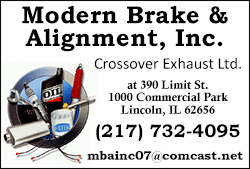|
High-tech dashboards
signal big changes for auto parts suppliers
 Send a link to a friend
Send a link to a friend
 [June 29, 2017]
By Alexandria Sage [June 29, 2017]
By Alexandria Sage
SAN FRANCISCO (Reuters) - Peer at the
instrument panel on your new car and you may find sleek digital gauges
and multicolored screens. But a glimpse behind the dashboard could
reveal what U.S. auto supplier Visteon Corp found: a mess.
As automotive cockpits become crammed with ever more digital features
such as navigation and entertainment systems, the electronics holding it
all together have become a rat's nest of components made by different
parts makers.
Now the race is on to clean up the clutter.
Visteon is among a slew of suppliers aiming to make dashboard innards
simpler, cheaper and lighter as the industry accelerates toward a
so-called virtual cockpit - an all-digital dashboard that will help
usher in the era of self-driving cars.
What's at stake is a piece of the $37-billion cockpit electronics
market, estimated by research firm IHS Market to nearly double to $62
billion by 2022. Accounting firm PwC estimates that electronics could
account for up to 20 percent of a car's value in the next two years, up
from 13 percent in 2015.
Meanwhile, the number of suppliers for those components is likely to
dwindle as automakers look to work with fewer companies capable of doing
more, according to Mark Boyadjis, principal automotive analyst at IHS
Markit.

"The complexity of engineering ten different systems from ten different
suppliers is no longer something an automaker wants to do," Boyadjis
said.
He estimates manufacturers eventually will work with two to three
cockpit suppliers for each model, down from six to 10 today.
DIGITAL MAKEOVER
One of Visteon's solutions is a computer module dubbed "SmartCore." This
cockpit domain controller operates a vehicle's instrument cluster,
infotainment system and other features, all on the same tiny piece of
silicon.
So far this year, the Detroit-based company has landed two big contracts
for undisclosed sums. One, announced in April, is with China's
second-largest automaker, Dongfeng Motor Corp. The other is with
Mercedes-Benz <DAIGn.DE>, Reuters has learned. Mercedes did not respond
to requests for comment. Another unnamed European automaker plans to use
the system in 2018, according to Visteon.
Visteon is going all in on cockpit electronics, having shed its
remaining automotive climate and interiors businesses in 2016. The bet
so far is paying off. The company secured $1.5 billion in new business
in the first quarter, helped by growth in China. Visteon's stock price
is up more than 50 percent over the past year.
It's a major turnaround since Visteon was spun off from Ford Motor Co <F.N>
a decade ago. Visteon filed for bankruptcy protection in 2009 before
emerging a year later.
"You have to be changing and adapting fast. If not, you're not going to
keep up in this market," said Tim Yerdon, Visteon's head of global
marketing. "It's about reinventing yourself to stay ahead."
DASHBOARD DEALS
Visteon's makeover hints at the coming battle between suppliers fighting
for real estate in the digital cockpit. The trend is already triggering
acquisitions, as companies look to boost their offerings to automakers.

Visteon in 2014 bought Johnson Controls' <JCI.N> electronics business,
which was also developing a domain controller. In March, Samsung
<005930.KS> completed its $8-billion purchase of infotainment company
Harman. France's Faurecia <EPED.PA>, a top seating and interiors
supplier, last year purchased a 20 percent stake in Paris-based
infotainment firm Parrot Automotive SAS in a deal that could make
Faurecia the biggest shareholder by 2019.
[to top of second column] |

Alexandra Schaefer, head of the SmartCore-Center of Competence and
her colleague Hector Zarate of U.S. automotive supplier Visteon work
on a set-up to demonstrate their new 'SmartCore' dashboard at the
companies technical center in Karlsruhe, Germany June 23, 2017.
Picture taken June 23, 2017. REUTERS/Ralph Orlowski

Deal-making in the wider automotive sector has been at a fever pitch
over the past two years fueled by the race to develop autonomous vehicle
technology. Activity in the sector was worth $41 billion in 2016,
according to PwC.
Analysts say German automakers are taking the lead in consolidating
functions within the dashboard. Audi <NSUG.DE> was the first to debut a
virtual cockpit last year that combined its instrument cluster and
infotainment system.
CHEAPER, LIGHTER, SMARTER
Streamlined dashboards can lead to cost reductions for manufacturers,
who can save as much as $175 per car with an integrated cockpit,
according to Munich-based management consulting firm Roland Berger.
They can also help with fuel efficiency. That's because vehicles are
lighter when there are fewer behind-the-scenes computers, known as
electronic control units (ECUs). Vehicles today contain 80 to 120 ECUs,
numbers expected to fall sharply in coming years.
But perhaps the biggest motivation for fancy cockpits is sales. Drivers
accustomed to the seamless technology of their smartphones are finding
today's dashboard offerings clunky and non-intuitive. A J.D. Power study
released this month found the most complaints from new vehicle owners
stemmed from audio, communications, entertainment and maps systems.
Better cockpits could prove crucial to attracting younger consumers, who
are not showing the same enthusiasm for cars, or even driving, that
their parents did. Research company Mintel found that 41 percent of
millennial car buyers are interested in having the latest technology in
their vehicles.
Disjointed dashboards "are one of the most noticeable gaps in user
experience - what you see right in front of you," said Andrew Hart of
UK-based consultancy SBD Automotive.

On many car models, he said, audible warning systems to alert the driver
to a potential collision are not in sync with the radio, meaning your
favorite song could drown out the warning beep.
"That's a crazy example of something when you don't consolidate ECUs,"
Hart said.
Industry watchers say this and other safe-driving features are among the
systems ripe for integration. Additional targets include rear-seat
entertainment systems and so-called heads-up displays that project data
such as the car's speed onto the windshield for easy viewing.
Back in Detroit, Visteon says it is in talks with carmakers in China and
Europe for its domain controller, a technology it hopes can give it an
edge over rivals such as Delphi <DLPH.N>, Robert Bosch [ROBG.UL],
Continental <CONG.DE>, and Denso <6902.T>.
While it isn't clear who will prevail, electronics suppliers are seeing
their products take on new importance as vehicles become more connected.
Five years ago, the dashboard was "a plastic molded cockpit that we
stuffed electronics into," said Yerdon, Visteon's marketing chief. "Now
it's more about an electronic architecture that's experience-driven, and
we mold plastic around it."
(Editing by Marla Dickerson)
[© 2017 Thomson Reuters. All rights
reserved.] Copyright 2017 Reuters. All rights reserved. This material may not be published,
broadcast, rewritten or redistributed. |